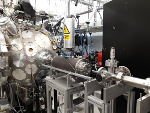| Version 2 (modified by , 4 years ago) ( diff ) |
|---|
WP4 Meeting with the Project Office
Timeline for Project:
2 yr design and simulate for LhARA stage 1: 12MeV in – vitro expts. Standard dish puts bragg peak in cell layer – hence 15MeV target to give ‘headroom’
5 yr build for LhARA stage 1. in – vitro expts by biologists proof of principal. Clinical system is longer term. 5+ yrs
TPrice
- the 36MeV system in Birmingham produces tracks with bragg peak at approx – 13mm of water.
- 12-15MeV tracks will be shorter ~few mm in water.
How could one resolve the peak in such a short track?
- Requires high resolution –which in turn requires high frequencies.
- Requires different sensors from higher energy system.
From this we conclude
- Lots of challenges for a low energy system.
- Low energy test does not de-risk the high energy system.
What spatial resolution does the map need to be useful to biologists – Action CW: to contact JP to ask.
Does the photoacoustic system with high resolution offer advantages for ‘mini-beam’?
Discussion surrounding alternative to BHam and Cern sources @ intermediate energy.
- Medical places are usually 100’s MeV and long pulse.
- TPrice Daresury AVO. 4 stage project – could have been within 2 years – short sharp pulses. Action TP to contact AVO
- Surrey synchrotron – low energy.
- 60MeV Clatterbridge. 30mm penetration.
- Clinical centres struggle to get below 70MeV with cyclotrons and dose rate is low.
- Conclude there are no alternatives – apparently LhARA will indeed be unique.
Group concludes:
2 activities are required
- LhARA consortium proves it has capability to detect a signal – can use any source. This is not a world first, but necessary.
- 12-15MeV system design – LhARA phase 1 needs a diagnostic Phase 1 will run for 5-10 years
Should simulate beams at low energies. Action KL: to adjust C++ code Mechanics of system are also a subject for discussion.
